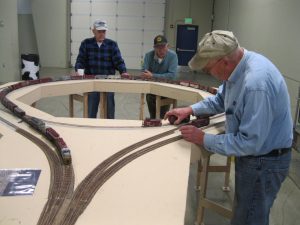Alan Ashton
Editors note: Alan Ashton maintains a Free-mo e-mail list (to join, e-mail Alan at inwafreemo@gmail.com) and is a member of the Inland Washington Free-mo Modelers. A previous post on 5th Division Free-mo activities can be viewed by clicking here, and the latest article on Free-mo standards and construction can be viewed by clicking here.
The Fall Spokane Train Show was held on October 9th 2016 and the Free-mo layout was set up the day before. We had approximately 70 feet of mainline track and about 17 modules plus two return loops. Everything went pretty well during setup and trains were running before noon. One train ran successfully with 44 cars (including caboose) as a “stress test” for the layout.

